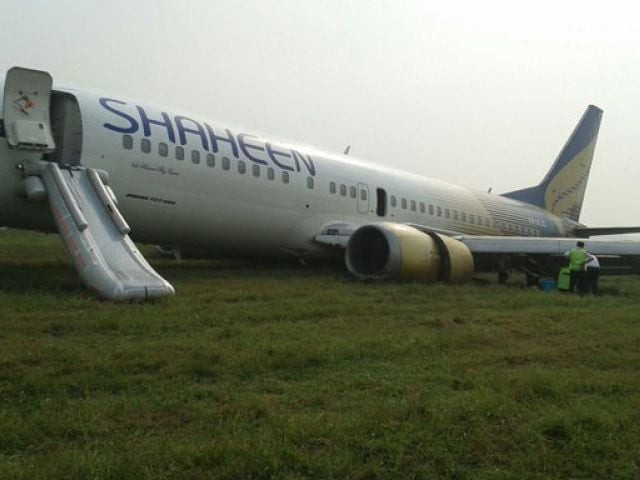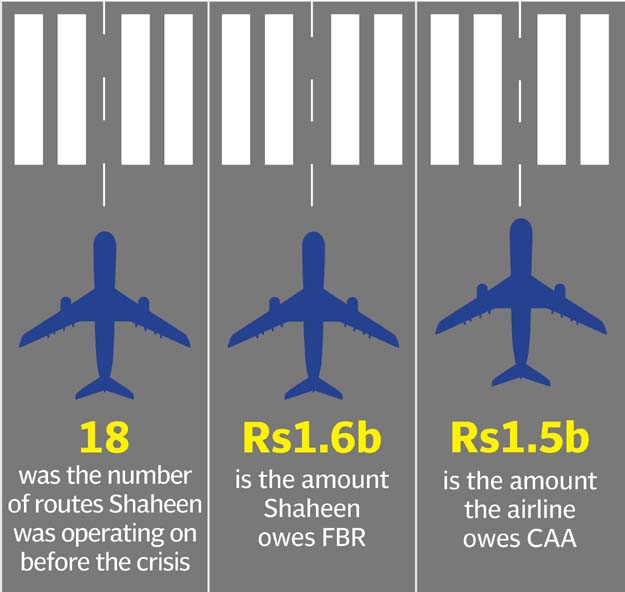Shaheen Air looks to spread its wings again
Airline needs around Rs3.1 billion to resume flights

Flight NL-154 crash landed at Allama Iqbal International on November 3. PHOTO: MALIK SHAFIQ / EXPRESS
The airline, which needs around Rs3.1 billion to resume operations, has taken on board its stakeholders in the Middle East, East Asia and western regions to arrange required funds, an airline official, who requested anonymity, told The Express Tribune.
Shaheen Air ordered to pay Rs0.1m to each affected passenger
Shaheen’s flight operations have remained suspended since May 2018, except for special Hajj flights and the flight that brought back stranded Pakistanis in China.
“We will simultaneously resume operations on all the 11 routes on which we were flying prior to the suspension of operations,” he said.
The routes included regions and countries like the Middle East and China and three domestic destinations Karachi, Lahore and Islamabad, he said.
Much before the current financial crisis hit the airline, it was operating on 18 routes with more than 15 aircraft. The fleet size has now cut down to seven after the airline returned five recently leased A-319 jets and some of the aging aircraft were permanently grounded.
Responding to the speculation echoing in the market that the airline had been sold to a Saudi Arabia-based investor, which would soon take over the management control; he said, “We are reviewing all the available options for the financial arrangement.”
He, however, cautiously ruled out the management change.
“The law does not allow selling 100% stake in any of the local airlines to foreign investors. Local airlines must retain the majority 51% stake,” he said. “Secondly, if we are to give shareholding to a Saudi Arabia-based investor, then we need to have a local partner in Saudi Arabia (which is not the case at this point in time),” he added.
The official added that Shaheen Air had taken on board all the stakeholders in the UAE, Kuwait, Saudi Arabia, Oman and China (who operate in their respective countries on behalf of the airline) for the financial arrangement.
He, however, did not clarify the mode of the financial arrangement whether it would be a loan, an investment, a mixture of the two, or some other option. “We are working from dawn to dusk …very soon we will give you good news regarding the required financial arrangement,” the official stressed.

The Sehbai family, which owns the airline, is looking in multiple directions to revive the airline, including arranging the financing from their friends and other resources.
Besides, the airline is also working with local travel agents to cope with the situation. “We are also working to recover stuck revenue from local travel agents that come to around 50-70% of the required money…they are cooperating beyond expectation.”
He ruled out the possibility of bankruptcy and replied, “We would resume operations by December or latest by January 2019.”
He elaborated that the airline owed Rs1.6 billion to the Federal Board of Revenue (FBR) and another Rs1.5 billion to the Civil Aviation Authority (CAA) on accounts of taxes and services, respectively. The dues accumulated in the three months prior to the suspension of operations by the airline.
The rupee depreciation of around 9.6% to Rs115.61 to the US dollar from December 2017 to April 2018 also badly hit the financial health of the airline as it makes majority of its payments in dollars.
Shaheen Air to bring back stranded passengers from China on Sunday night
Market talk suggests that the default by the airline is not only the primary reason for the suspension of operations, but other airlines’ monopolistic and anti-competitive influence and lack of a level playing field also pushed the airline to the verge of closure.
Currently, the one-way fare for Karachi to Islamabad flight has shot up to Rs14,000 to Rs23,000 compared to between Rs10,000 and Rs14,000 prior to SAI’s suspension of operations.
SAI Chief Marketing Officer Zohaib Hassan said, “SAI had two ways to normalise its financial planning, either SAI would close its operation and clear dues in a normal way of all agencies or they had to operate as normal and delay the payments to the agencies like FBR and CAA, as SAI also practiced in the past.”
He said the airline followed the latter option, however, the CAA started closing the profitable sectors due to which Shaheen was now facing a crisis.
In the last 20 years, at least four local airlines have shut down in Pakistan, while the four in operation remain in trouble these days. Besides, another four airlines have announced acquiring flying rights, but remained non operative due to non-friendly behaviour of CAA, he added.
Published in The Express Tribune, October 26th, 2018.
Like Business on Facebook, follow @TribuneBiz on Twitter to stay informed and join in the conversation.



















COMMENTS
Comments are moderated and generally will be posted if they are on-topic and not abusive.
For more information, please see our Comments FAQ